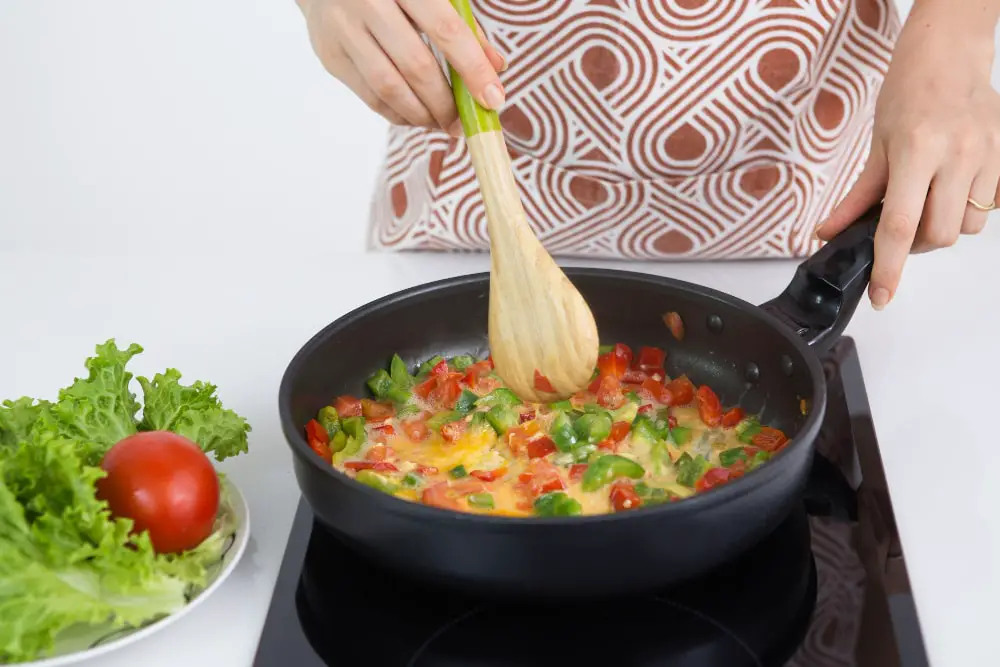This post contains affiliate links. When you buy through our links, we may earn a commission.
Induction cooking has the potential to transform your cooking experience completely. Instead of using the cooktop, induction technology uses magnetic currents to heat your pots and pans directly.
Cooking with induction simplifies mealtime by providing faster heat, precise power, and simple cleanup.
- What Is Induction Cooking?
- How Does Induction Cooking Work?
- Are Induction Cooktops Safe?
- Is Induction Good For Cooking?
- Why Is Induction Cooking Bad?
- Is Induction Cooking Safe During Pregnancy?
- Why Is Induction Cooking Not Popular?
- What Type of Cookware Can Be Used with Induction Cooking?
- Can You Touch The Induction Cooktop?
- Induction Vs. Gas, which is better?
- Induction Vs. Better Electric?
- Things to Consider About Induction Cooking?
- Conclusion
What Is Induction Cooking?
Induction ranges resemble traditional glass-top electric ranges. The most noticeable change is that since the electric field on an induction cooktop does not produce a light, you may not realize it is turned on.

As a result, vendors have begun to use simulated fire and other lighting cues. Induction range ovens broil and roast in the same way as most electric ovens.
How Does Induction Cooking Work?
Heaters are used for induction heating on a flat glass plate. Cookware heating coils are powered by electromagnetic energy, which is only activated by iron. If the iron particles meet the working heaters, they agitate, causing the pan to heat up quickly.
In contrast to what occurs on an electric or gas range, heat is not transmitted from the burners to the cookware; instead, the pot or pan heats up while the cooktop remains cool – and clean to the touch!
There is no need to wait for the burner to heat up before using this process, which is quicker than using energy or gas. Here is what you can do before making your decision.
Are Induction Cooktops Safe?
When purchasing a new gadget for your home, keep protection in mind. Cooktops and ranges emit heat, and induction is no exception.
Since induction heats the cookware rather than the cooktop surface, the surface will not become hot until the proper cookware is placed in the cooking area. It also cools better than standard gas or electric cooktops.
This is an essential concern for families with children. When a pot or pan is removed from the cooktop, the induction components turn off automatically, minimizing the possibility of accidentally flipping on a burner.
Is Induction Good For Cooking?
While there are many reasons why induction technology is preferable to more conventional cooking appliances, the four main benefits of an induction cooktop are as follows:
1. Easier Dinner Preparation
With induction, heat is applied directly to the cookware rather than the cooktop surface. Because of this, induction cooktops heat up and boil water 50% faster than electric or gas cooktops.
2 Reliable and delectable performances
Induction cooktops have more accurate temperature control than gas or electric cooktops. This enhanced temperature control results in more consistent efficiency, reducing the possibility of overcooking or undercooking. Consistent heat produces delectable and repeatable results at any time.
3. Easily swept
Induction cooktops, like standard induction cooktops, have a smooth, glass cooktop. On the other hand, induction burners do not heat the cooktop’s surface, so any spills, splatters, or occasional boil-overs will not burn through the cooktop.
When you finish cooking, the cooktop will be cool enough to clear up any mess that has been left behind quickly.
4. Always Perfect Fit
Frigidaire Induction cooktops use auto Sizing pan detection to guide heat where it is required. By automatically adjusting to the scale of your cookware, no energy is wasted.
Why Is Induction Cooking Bad?
Since the technology is still relatively modern, induction stoves are often more expensive than their electric and gas counterparts. It’s an investment, but if you’re hunting for a new collection, it’ll be worthwhile: A smooth-top electric range uses 10% less energy than an induction device.
Furthermore, as induction becomes more widespread, the cost is gradually decreasing. Specialized cookware is needed for induction stoves and cooktops.
Although most cookware, especially stainless-steel cookware, is induction compatible, you must replace older cookware if you opt for induction. When iron particles in induction-safe cookware meet induction heaters, they enable and produce heat. Make sure new pots and pans are labeled “induction clear.”
If you have some reservations for older ones, do the magnet test: if a magnet sticks to the rim, it can be used for induction.
Is Induction Cooking Safe During Pregnancy?
According to the analysis and technical assessment of available evidence, low-frequency electromagnetic radiation from induction cooking units has no adverse impact on anybody, including pregnant women, other than people with implanted electronic medical devices.
Still, for those who are too cautious, keep at least a foot (or 30 cm) away from an activated induction system, ultimately reducing the RF radiation effect on humans (if any).
Why Is Induction Cooking Not Popular?
Induction cookware only fits with exclusive (but widely available) cookware. To create a magnetic field, you will need iron in your pots and pans.
Induction is compatible with most stainless-steel pots and pans, as well as all cast-iron pots and pans. Copper, aluminum, and ceramic wares are all useless. All Wire cutter’s saucepans, skillets, cast-iron bowls, cookware sets, and Dutch ovens are compliant with inductive cooking.
Induction cooktops begin at $1,000, just a few hundred dollars less than gas or electric cooktops. The Bosch induction slide-in series, for example, starts at $3,500.
A flawless induction machine can be purchased for hundreds of dollars less than a gas-powered model. Also, decent single-element induction cookers cost about $70.
Induction has not been widely publicized. Many designers and remodelers are still unfamiliar with the term “induction.” Induction appliances are not sold in most big-box retailers’ showrooms.
What Type of Cookware Can Be Used with Induction Cooking?
Stainless steel multi-ply cookware is composed of bonded metal. These metal layers are made up of a series of core layers sandwiched between two outer layers.
The outer layers are made of a substance that is non-reactive and food-friendly. The inner layers are made of a metal that easily, effectively, and uniformly distributes heat.
Can You Touch The Induction Cooktop?
Yes, Induction cooktops are easier to use than electric or gas cooktops. It does not emit gas into the atmosphere and will not catch objects on fire, such as dishcloths, so it only heats products that contain iron particles.
It even turns off when the cookware is removed from the heating unit, so there is no risk of accidentally turning it on until you are done cooking.
Induction Vs. Gas, which is better?
Your cooking style and tastes will strongly affect the cooktop you choose. People frequently tend to be pro-gas, and that is what they know.
Induction cooktops are relatively new to the US market, but those in Europe who have used them for some time may have a favorable opinion of the operation.
When deciding what is best for you, have the following in mind :
You are referring to the safety features. For example, if you have small children, the possibility of burns and gas leaks can deter you from using gas cooktops.
The expense is an essential factor. Of course, gas cooktops are far less costly. Some fundamental models can be found almost anywhere. However, if you are more concerned with expense, design style, and operation, an induction cooktop is the way to go.
Induction Vs. Better Electric?
Electric cooking is more like induction cooking than gas cooking, although there are also variations between the two. Many induction or electric ranges, unlike gas ranges, do not need any special hookup other than a 220-240v plug.
On the other hand, induction allows a cook to adjust the heat level more precisely than electric; when a pan is used for induction heating, the temperature changes as the current is adjusted. This is not the case for electricity since the pan takes longer to exceed the temperature of the heat source.
If the initial cost is a significant factor, electric cooking would almost certainly prevail. Electric cooktops are less costly than induction cooktops because they do not necessitate the use of specialized cookware. Even though induction cooking has many benefits, electric cooking is unquestionably the more cost-effective option.
Things to Consider About Induction Cooking?
-
You can detect any sounds associated with a fan turning on inside or the cookware’s lids vibrating on higher settings. A ticking sound is sometimes heard because of power controllers cycling the element on and off to keep the power steady.
-
You need not be worried about the sounds since they are entirely normal.
-
Food cannot be charred when cooked in an induction oven.
-
Many that like roasting peppers or marshmallows would be disappointed.
-
The minimum base height varies depending on the standard.
-
Make a wise choice and go for the induction, keeping all the points raised above in view.
Conclusion
While induction requires some adjustment, we love the unrivaled temperature control that induction cooktops offer. Induction cooktops, instead of electric cooktops, cook food better, respond to temperature variations more efficiently, and take less time to cool off.
As a result, induction cooktops are very easy to clean and unquestionably more excellent than gas and electric cooktops.
